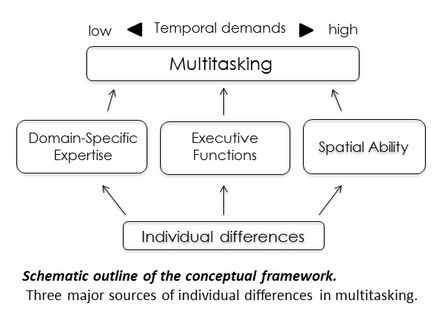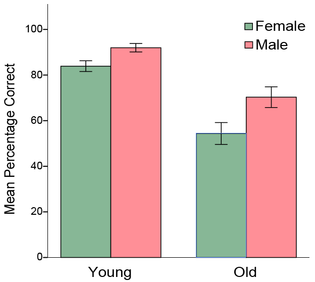SPATIO-TEMPORAL MODEL oF MULTITAsKING
|
empirical SUPPORT FOR THE SPATIO-TEMPORAL MODEL
We have gained empirical support for the spatio-temporal model of MT from several studies aiming to test the hypothesis and its boundary conditions. Our main findings are outlined here.
The emergence of both executive functions and spatial ability as two independent predictors in MT performance was the main finding in an article published in the journal Psychological Science (Mäntylä, 2013). This finding has also been replicated in follow-up studies, investigating the involvement of spatial ability and executive functions in multitasking.
Another intriguing finding, based on data collected across several studies, is that sex differences in MT are mediated by spatial ability. Inconsistent with popular beliefs (see Media Coverage), men actually exceeded women in MT performance, and this difference reflected sex-hormone related differences in spatial ability. In several studies involving participants from different populations and countries, we have found sex differences in MT between males and females in the luteal phase – during which the estrogen levels are elevated – but not for females at the menses.
The emergence of both executive functions and spatial ability as two independent predictors in MT performance was the main finding in an article published in the journal Psychological Science (Mäntylä, 2013). This finding has also been replicated in follow-up studies, investigating the involvement of spatial ability and executive functions in multitasking.
Another intriguing finding, based on data collected across several studies, is that sex differences in MT are mediated by spatial ability. Inconsistent with popular beliefs (see Media Coverage), men actually exceeded women in MT performance, and this difference reflected sex-hormone related differences in spatial ability. In several studies involving participants from different populations and countries, we have found sex differences in MT between males and females in the luteal phase – during which the estrogen levels are elevated – but not for females at the menses.
|
Individual and sex-related differences in MT reflected selective effects of spatial ability. In a recent study (Todorov et al., 2015; Memory & Cognition), we adopted the idea that spatial-relation processing involves two basic spatial abilities, referred to metric (coordinate) or nonmetric (categorical) processing. We found that individuals who were good at coordinate, rather than categorical, spatial processing were also better multitaskers than individuals with less efficient metric spatial skills. Furthermore, coordinate (but not categorical) processing was highly sensitive to fluctuations in sex steroids. |
ONGOING WORK
- Based on our conceptual framework and empirical findings, we are investigating whether concurrent spatial load has detrimental effect on MT-performance? Are these concurrent effects selective with larger effect in metric than nonmetric spatial tasks, and possibly accentuated by fluctuations in sex steroids?
- Combining behavioral data and neural correlates, we test the hypotheses that MT involves spatial processing and that these effects reflect selective activations of cortical areas associated with metric spatial relation processing.
- Test the complementary prediction that training of (transformational aspects of) spatial ability facilitates MT performance and its neural correlates.
MeDIA COVERAGE
|
Please, click on the following newspaper-links to access the original articles reporting our findings:
|





